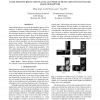Free Online Productivity Tools
i2Speak
i2Symbol
i2OCR
iTex2Img
iWeb2Print
iWeb2Shot
i2Type
iPdf2Split
iPdf2Merge
i2Bopomofo
i2Arabic
i2Style
i2Image
i2PDF
iLatex2Rtf
Sci2ools
ICASSP
2007
IEEE
2007
IEEE
False Positive Reduction in Lung GGO Nodule Detection with 3D Volume Shape Descriptor
Lung nodule detection, especially ground glass opacity (GGO) detection, in helical computed tomography (CT) images is a challenging Computer-Aided Detection (CAD) task due to the enormous variances in nodules’ volumes, shapes, appearances, and the structures nearby. Most of the detection algorithms employ some efficient candidate generation (CG) algorithms to spot the suspicious volumes with high sensitivity at the cost of low specificity, e.g. tens even hundreds of false positives per volume. This paper proposes a learning based method to reduce the number of false positives given by CG based on a new general 3D volume shape descriptor. The 3D volume shape descriptor is constructed by concatenating spatial histograms of gradient orientations, which is robust to large variabilities in intensity levels, shapes, and appearances. The proposed method achieves promising performance on a difficult mixture lung nodule dataset with average 81% detection rate and 4.3 false positives per v...
False Positives | ICASSP 2007 | Lung Nodule Detection | Signal Processing | Volume Shape Descriptor |
| Added | 02 Jun 2010 |
| Updated | 02 Jun 2010 |
| Type | Conference |
| Year | 2007 |
| Where | ICASSP |
| Authors | Ming Yang, Senthil Periaswamy, Ying Wu |
Comments (0)

